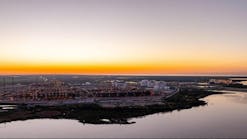A producer group June 8 said if US meteorologists' predictions about a warmer-than-normal summer materialize, natural gas prices that likely will rise, assuming the economy continues to strengthen and North American gas production stays flat.
The Natural Gas Supply Association released its second annual snapshot of what it expects the summer market to look like, and the outlook is similar to last year in that the association's report, prepared by Arlington, Va.-based Energy Ventures Analysis Inc., predicts there will be a tight balance between supply and demand over the next few months.
Although NGSA did not predict exactly what wholesale and retail gas prices would look like, it said overall market costs probably will be higher. The usual variables of weather, the economy, and demand increases in specific market sectors are part of the reason why higher prices are expected this year.
Unlike last year, storage and production are expected to be less of a factor for cost run-ups this summer. But that probably won't be enough to offset a wave of higher overall energy costs among competing fuels, NGSA said.
Other "wild cards" that can move the market are hydroelectric output, now projected at levels only reaching the 80% mark; hurricanes; more-stringent pipeline maintenance schedules; and global oil market fluctuations.
But weather remains the largest single factor affecting natural gas prices, and it is also the most difficult to predict, NGSA noted.
Supply-demand crunch
Although producers are drilling at a 3-year high level, with more than 1,000 rigs now operating in the US, they face the challenge of extracting gas from mature supply regions where output is naturally declining, NGSA officials said.
"Producers are responding to increased demand, but we are working harder and harder just to keep production levels constant," said Joseph Blount, NGSA chairman and president of Unocal Corp.'s Midstream & Trade division. "We are focused right now on getting as much natural gas to market as possible and putting enough in storage to meet the upcoming winter months with sufficient supply. Unfortunately, though, there is little short-term relief for customers."
According to the NGSA-commissioned forecast, the US's overall demand will increase as much as 3%, up from 49.5 bcfd last summer to 51 bcfd this summer. Demand from the electric power generation sector is expected to be a big growth area because of higher air conditioning load and reduced hydroelectric output in the Pacific Northwest and California.
In the residential and commercial sectors, summer demand is expected to remain relatively constant, but industrial customers, which absorb most of the US gas supply, likely will face a "continuing growth challenge, given these tight market conditions," the NGSA report said.
Looking at supply, imports will play an increasingly important role. LNG imports are expected to increase 50% this summer, from 1.6 bcfd last summer to 2.4 bcfd. But there will be slightly less Canadian gas delivered to the US because of higher demand; so overall imports will be flat. That makes passing energy legislation that helps reduce supply constraints is a top priority for industry, NGSA said. But many industry lobbyists say any sweeping bill that addresses the issue may stay mired in election-year theatrics.
One promising development is that the storage situation is better than last year. Last summer the industry entered the cooling season with inventories at a 5-year low. This season, NGSA says industry is entering the summer with storage closer to the 5-year seasonal average, with injections averaging more than 70 bcf/week. That should result in a level approaching 3.2 tcf over the period, which may apply some limited downward pressure on the wholesale market.
NGSA suggested its outlook is generally in line with US government and private estimates, although it said that its supply numbers are a little more conservative than most because its study surveyed a "wider spectrum" of the market, and not just big producers that make up only 30% of the US market.

